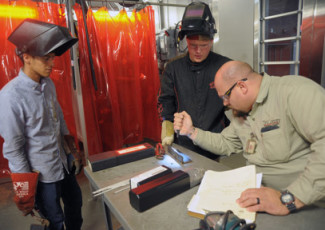California System Adopts Workforce Recommendations
By Dennis Pierce
December 28, 2015
How the task force led the way to approval, and what’s needed to put these plans into action.
The leaders of the California Community Colleges system have adopted a set of 25 recommendations to help fill the state’s need for an estimated 1 million more credentialed workers within the next decade.
Last month, the California Community Colleges Board of Governors voted unanimously to adopt the recommendations of the California Task Force on Workforce, Job Creation and a Strong Economy.
The recommendations include improving the quality and accessibility of workforce data; revising the curriculum-development process to ensure closer alignment with employers; improving the number and quality of career and technical education (CTE) instructors; developing more career pathways that include “stackable” components for moving students to successively higher levels of education and training; enhancing career awareness, pathway planning and job placement services; and establishing a supplemental funding source to help colleges create high-quality CTE courses.
Pushing the workforce recommendations through
Getting the board to approve the task force’s recommendations wasn’t hard, said Van Ton-Quinlivan, Vice Chancellor for Workforce and Economic Development of California’s Community Colleges — but only because the process that produced them was so thorough.
The board convened the task force in November 2014, inviting 26 people to join. Half were faculty and administrators from within the state’s community college system; the other 13 members “represented an array of stakeholders who rely on our system for workforce training,” Ton-Quinlivan says, including employers, labor groups and youth-advocacy groups.
Before the task force even met, state leaders held 14 regional conversations at various community colleges and six town-hall meetings with external stakeholders. From these meetings, a number of suggestions emerged that informed the task force’s work.
“This was really important in calling the good ideas out from the field,” Ton-Quinlivan says. “It was an open but structured process of generating ideas, building on these ideas, and then prioritizing them.”
Soliciting ideas from the field, and convening such a diverse group of stakeholders to deliberate on the topic, produced a final report that had “a tremendous amount of buy-in,” she says. “As one of the board members said to me, it’s rare to see Orange County and the Central Valley agree at this level, much less having the Chamber of Commerce and labor be on the same page.”
The task force recommendations “have bridged all of these different regions, as well as the labor and business communities, by positioning community colleges as vital to jobs and the economy,” she adds.
The recommendations were presented to the board in September, and the board adopted the measures at its following meeting in November.
What’s next: implementation
The California Community Colleges Chancellor’s Office is tasked with implementing the recommendations. “We will go back to the board in January with an implementation timeline; however, we’ve already begun the legislative strategy,” Ton-Quinlivan says.
Community college leaders will have a better sense of how the recommendations will affect their institutions when the chancellor’s office completes its implementation timeline. The board has asked for $200 million to support this work for 2016–17 and has requested a similar amount for subsequent years.








